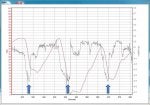The NHTSA says that many (I forget the percentage but it's high) accidents are caused by over use of the rear brake, and not enough front. I theorize that it's a normal learned reaction to stomp your foot in a panic, and not to grip a front brake! Many of these accidents according to a recent study had lots of rear brake and NO front brake, causing the bike to slide out of control or simply not stop in time. (as the bike will stop faster with front than rear).
For what it's worth, the MSF, which is a culmination of various studies and training over the years, teaches using both brakes applied at the same time with a bias towards the front. They also teach that if you do lock up the rear, to leave it locked to prevent it from suddenly grabbing and causing a high side, but to let off the front if it locks up and then re apply the correct pressure.
Whatever it is you feel is the right way for you to ride, practice it and make it intentional practice hard braking, practice using the brakes correctly, etc. don't make a left turning cager your first, or first in a while, experience with a hard stop.
Also, a good rider never panic stops, because they are not panicking. They are skilled, educated, aware and well practiced. They are simply making a maximum effort stop because they have determined it is the best accident avoidance strategy for that particular scenario!
Also, while we're on the subject, I think braking IS the best strategy for many situations. Some people speed up and swerve in situations I think hard braking would be much better, but because they don't practice, they aren't confident enough to do it. Then there is the ever present "I had to lay it down". Well, modern rubber tires will stop much better than plastic and metal! I've also heard that "I'd rather slide into it or slide under it than go over it". Well, as for me, I'd rather hit it at 10 with some level of control as to where I go after that than to slide into it at 30 (because I reduced my rate of deceleration when I laid it down) and go who knows where, potentially into oncoming traffic.
-John





